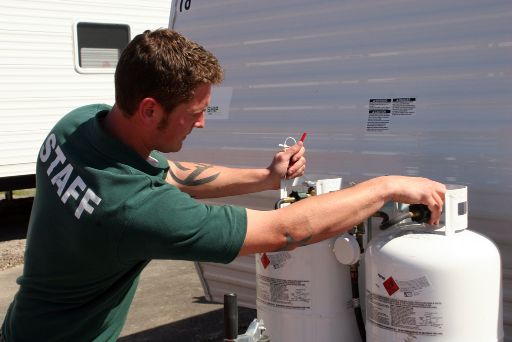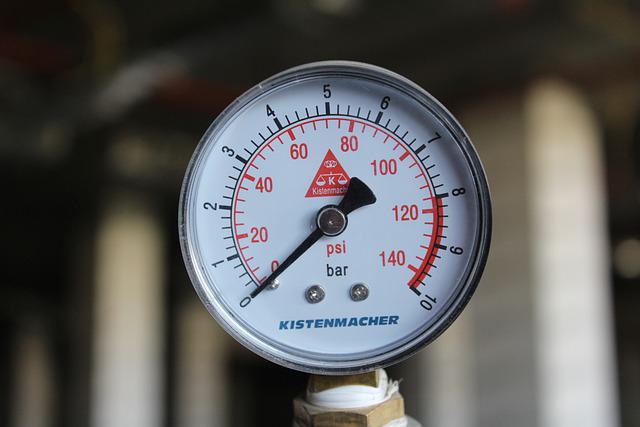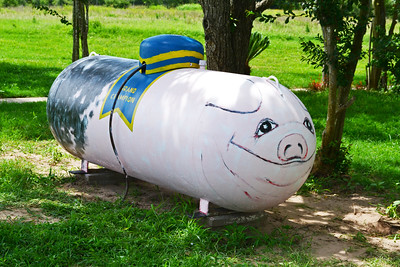
When it comes to building a fire pit, one of the most important considerations is how far away it should be from any potential hazards. This is especially true if you plan on using a propane tank to fuel your fire. So, how far does a fire pit need to be from a propane tank?
Fire pits and propane tanks
A fire pit should be at least 10 feet away from a propane tank. It is important to keep the fire pit away from the propane tank so that the heat from the fire does not cause the tank to explode. Also, the fire pit must be installed 20 feet away from your house or any nearby building. The ground must be level and there should be no flammable or combustible materials near the pit location.
Take into consideration also the distance requirements as every state may have its own regulations with regard to this matter. Visit the website of the related government authority of the state where you are in to know the regulation.
Recommended Minimum Distances
A. General Guidelines for Fire Pit Placement from Propane Tanks
Safety is paramount when installing a fire pit near a propane tank. The recommended minimum distance between a fire pit and a propane tank typically follows guidelines set by local regulations and fire safety codes, which often reflect the standards established by the National Fire Protection Association (NFPA). As a rule of thumb, fire pits should be placed at least 10 feet away from a propane tank as mentioned above. This distance may need to be increased depending on additional factors discussed below.
B. Factors that Affect Safety Distance
Several factors can affect the safe distance a fire pit should be from a propane tank, which includes:
- Propane Tank Size
The capacity of the propane tank is a critical factor. Larger tanks contain more fuel and thus have a higher risk potential. For example, while a 10-foot distance may be sufficient for a standard 20-pound propane tank, larger residential tanks that are 100 pounds or more may require additional distance to mitigate the risks in the event of a leak or fire. - Fire Pit Size and Type
The size of the fire pit and the type of fuel it uses can also impact the necessary safety distance. Larger fire pits that produce more heat or those that burn wood, which can spark and create embers, may necessitate greater spacing than smaller, gas-fueled fire pits which typically have a more controlled flame. - Surrounding Environment and Structures
Consideration must be given to the surrounding environment, including wind patterns, vegetation, and other flammable structures. In areas with dense vegetation or where there are wooden decks, outbuildings, or fences, a greater distance will be required to prevent the spread of fire. Environmental conditions such as frequent high winds may also warrant additional safety margins.
Ultimately, while general guidelines can provide a baseline, it’s essential to consult with local fire codes and possibly a fire safety professional when determining the appropriate placement for a fire pit relative to a propane tank. Their specific recommendations will take into account all the factors unique to your situation to ensure that your fire pit is both enjoyable and safe.
Best Practices for Fire Pit Placement and Use
Assessing the Ideal Location for a Fire Pit
When choosing where to place your fire pit, safety should be your top priority. Make sure it’s set on a non-combustible surface and clear from anything that could easily catch fire. You’ll also want to think about wind patterns and choose a spot where smoke won’t be an issue for you or your neighbors. Besides safety, consider the aesthetics and convenience—find a place where the fire pit can enhance the ambiance of outdoor gatherings without being in the way.
Creating Barriers or Using Covers for Additional Safety
To keep your fire pit experience safe and enjoyable, consider using a spark guard or screen. This can help contain embers and prevent accidental fires. You might also want to install a permanent barrier, like a ring of stones or a metal enclosure, which can clearly mark the fire pit zone and keep children and pets at a safe distance. And don’t forget to cover your fire pit when it’s not in use to protect it from the elements and reduce the risk of unintentional ignition.
The Importance of Regular Maintenance and Inspections
Maintaining your fire pit is key to ensuring it remains a safe addition to your backyard. Regularly check for signs of damage or corrosion and keep the pit clean from ash and debris that could affect its safe operation. It’s also wise to have a professional periodically inspect your fire pit and propane tank, especially before the start of the season when you’ll use it most. If you ever notice anything amiss, address it immediately—never use a fire pit that seems unsafe.
Remember, a well-maintained fire pit is one that you can enjoy without worry, creating a cozy gathering spot for friends and family for many seasons to come.
Your Alternatives
When considering the cozy addition of a fire pit to your outdoor space, it’s crucial to factor in the proximity of propane tanks and the inherent risks involved. For those with nearby propane tanks, traditional wood-burning fire pits might not be the safest option due to their open flames and flying embers. However, there are alternative solutions that allow you to enjoy a warm, inviting flame while mitigating safety concerns.
Propane Fire Pits as an Alternative
Propane fire pits are an excellent alternative to traditional wood-burning pits, particularly when you need to consider the placement relative to propane tanks. These fire pits run on propane gas and are designed with safety and convenience in mind. Here’s why they stand out:
- Controlled Burning: Propane fire pits provide a consistent and controlled flame that eliminates the unpredictability of wood fires. There’s no need to worry about sparks or embers that might stray and pose a fire hazard.
- Ease of Use: They start with the turn of a knob and often come with variable flame height controls, making them user-friendly and easier to extinguish than wood fires.
- Clean Burning: Propane is a clean-burning fuel, meaning it won’t produce the smoke, ash, or soot associated with wood burning. This not only means less cleanup but also a smaller environmental impact and less risk of smoke-related issues.
- Aesthetic and Functional Variety: Propane fire pits come in many designs, from table-style pits to those that mimic the look of traditional campfires, offering aesthetic flexibility to fit your outdoor decor.
Portable Fire Pits and Their Advantages
Portable fire pits offer a range of benefits, particularly for those who have spatial constraints or live in areas with strict fire regulations:
- Flexibility: They can be placed in various locations as needed, allowing you to adjust the setup for different events or times of the year.
- Space-Saving: When not in use, portable fire pits can be stored, freeing up outdoor living space for other activities.
- Versatility in Fuel: While many portable fire pits use wood, there are models that run on propane or gel fuels, providing options for those looking to avoid the smoke and maintenance of wood fires.
- Mobility: For those who enjoy camping or tailgating, portable fire pits can be an excellent way to bring the comfort of a fire pit to any outdoor setting.
Safety Considerations for Alternative Options
Even with the safer alternatives like propane and portable fire pits, certain safety considerations should always be maintained:
- Installation and Operation: Ensure that your alternative fire pit is installed according to the manufacturer’s guidelines and operated in a well-ventilated, open space to prevent carbon monoxide buildup.
- Surface and Surroundings: Place your fire pit on a stable, non-combustible surface and maintain a safe distance from flammable structures, including the propane tank, your house, trees, and outdoor furniture.
- Monitoring: Never leave the fire pit unattended while in use, and always turn off the propane supply when the pit is not being used.
- Emergency Preparedness: Have a fire extinguisher or water source readily available in case of an emergency, and familiarize yourself with how to use it.
- Maintenance: Regularly inspect your fire pit for leaks, cracks, or damage, especially if it uses gas. For portable fire pits, ensure that any moving parts are secure and in good working order before each use.
By considering these alternatives and adhering to the safety guidelines, you can create a warm and inviting outdoor space that prioritizes the safety of your property and loved ones.
What To Do in Case of Accident
In the event of an emergency related to fire pits and propane tanks, it’s essential to act quickly and calmly. Knowing what to do can prevent a minor incident from escalating into a dangerous situation. Here’s how to recognize and respond to potential emergencies:
Recognizing Signs of a Propane Leak
Being able to identify a propane leak can help avert a crisis. Here are the telltale signs:
- Smell: Propane has a strong, unpleasant odor that many liken to rotten eggs or skunk spray. This scent is an additive to help you detect leaks.
- Sound: A hissing or whistling sound near a gas line or tank could indicate that propane is escaping.
- Visual Cues: Look for visible signs like a white cloud or mist, bubbling in wet areas, or dead vegetation around the tank which could suggest a leak.
If you suspect a propane leak:
- Do not ignite or extinguish flames or electrical switches which could cause a spark.
- Evacuate the area immediately and keep others away.
- Call your propane supplier or the fire department from a safe distance to report the leak.
Steps to Take if a Fire Occurs Near a Propane Tank
In the unfortunate event that a fire starts near a propane tank, the priority is to ensure the safety of everyone around:
- Immediate Action: If it’s a small fire and you can access the valve safely, shut off the propane tank. However, if the tank itself is on fire, do not approach it.
- Evacuate: Get everyone to a safe distance from the fire immediately.
- Call for Help: Once you are at a safe distance, call 911 or the local fire department. Inform them about the propane tank and follow their instructions.
- Do Not Re-enter: Do not return to the area until emergency responders have declared it safe.
Emergency Preparedness and Having a Fire Extinguisher on Hand
Preparation is key to effectively dealing with an emergency:
- Type of Extinguisher: Ensure you have the correct type of fire extinguisher on hand – for a propane fire, you’ll need a class B fire extinguisher which is suitable for flammable liquids and gases.
- Training: Familiarize yourself with the use of the extinguisher beforehand—remember the acronym PASS: Pull the pin, Aim at the base of the fire, Squeeze the handle, and Sweep from side to side.
- Placement: Keep the extinguisher in an accessible location, near the fire pit but not so close that you can’t reach it in the event of a fire.
- Inspection: Regularly check the fire extinguisher for proper pressure and that it is in working order.
- Maintenance: Maintain all equipment related to your fire pit and propane tank, such as hoses, connections, and the tank itself, to prevent malfunctions that can lead to emergencies.
Being prepared and knowing how to respond to a propane-related emergency can significantly reduce the risk of injury or property damage. Regular maintenance, vigilance, and having the right tools at hand are the best ways to ensure you can enjoy your fire pit safely.
FAQs
When dealing with propane tanks and fire pits, it’s essential to follow safety guidelines to avoid potential hazards. Here’s a summary of the clearances and safety considerations for propane fire pits:
How close can you have fire to a propane tank?
The general safety rule is to keep a traditional open fire pit at least 10 feet away from propane tanks and other combustible materials or structures. This distance may need to be increased depending on local regulations, the size of the fire pit, and the capacity of the propane tank.
How much clearance is needed for a propane fire pit?
For propane fire pits specifically designed for use with propane gas, manufacturers will provide guidelines on clearances. It’s important to follow these guidelines. Typically, these are safer than open wood-burning fire pits since the flame is usually contained, but a minimum clearance of at least 3 feet from any combustible material is commonly recommended.
Can I put my propane tank under my fire pit?
It is generally not recommended to place a propane tank directly underneath a fire pit. Heat from the fire pit can cause the propane tank to overheat, increasing the pressure inside the tank, which could lead to a gas leak or explosion. However, some fire pits are designed with an integrated space or compartment specifically for a propane tank that shields the tank from direct heat—always follow the manufacturer’s instructions if this is the case.
How long can a propane tank run a fire pit?
The duration a propane tank will last depends on the BTU (British Thermal Unit) rating of your fire pit and the size of the propane tank. For example, a standard 20-pound propane tank can provide approximately 430,000-950,000 BTUs, depending on the purity of the propane. If your fire pit has a 50,000 BTU rating, you can expect roughly 8.6 to 19 hours of burn time from a full 20-pound tank. More precise calculations require the specific BTU rating of your fire pit and the exact capacity of your propane tank.
In conclusion
while fire pits can add a wonderful element to your outdoor living space, safety should always be paramount—especially when dealing with propane tanks. By understanding the alternatives to traditional wood-burning fire pits, such as propane or portable options, you can significantly reduce the risk of fire-related incidents. It is crucial to recognize the signs of a propane leak and know the steps to take in case of an emergency, including how to respond to a fire near a propane tank.
Being prepared with the right type of fire extinguisher, knowing how to use it, and ensuring that your fire pit area is well-maintained are all essential practices. Regular inspections and adhering to safety guidelines not only protect you and your loved ones but also ensure that the comforting glow of your fire pit remains a source of pleasure rather than concern.
Remember, the best way to enjoy a fire pit is with peace of mind, knowing that you’re fully prepared to handle any emergencies that may arise. Stay safe, and enjoy the warmth and ambiance that your fire pit brings to your outdoor gatherings.

Mike is an experienced propane technician with over 15 years of professional experience in the field. He has dedicated his career to helping customers with their propane needs, from installation to maintenance and repair. Together with Jeremy, he co-founded this website to provide useful information and guidance to customers seeking reliable propane services.




